21.5-inch iMac (Late 2013) Review: Iris Pro Driving an Accurate Display
by Anand Lal Shimpi on October 7, 2013 3:28 AM ESTCPU Performance
I ran the entry level iMac through our normal OS X CPU test suite. I don't have a ton of Mac desktops in the database but I do have results for last year's 27-inch iMac that'll help put things in perspective. Also keep in mind that the 21.5-inch iMac came equipped with a HDD, while nearly everything else I'm comparing it to has an SSD inside.
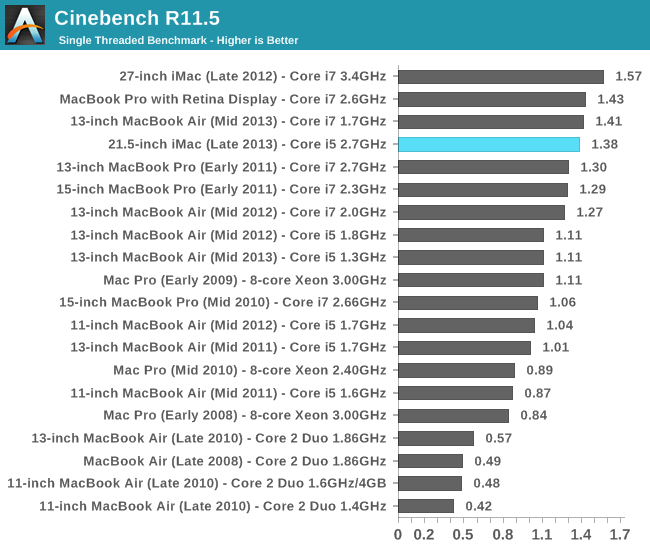
Single threaded performance is about on par with an upgraded 13-inch Haswell MacBook Air, which is sort of insane when you think about it. The Core i7 upgrade in the 13-inch MBA can turbo up to 3.3GHz, compared to 3.2GHz with the entry-level iMac’s Core i5. The amount of L3 cache dedicated to a single core is actually the same between both parts (at 4MB). In the case of Cinebench, the 128MB L4 cache doesn’t seem to do much.
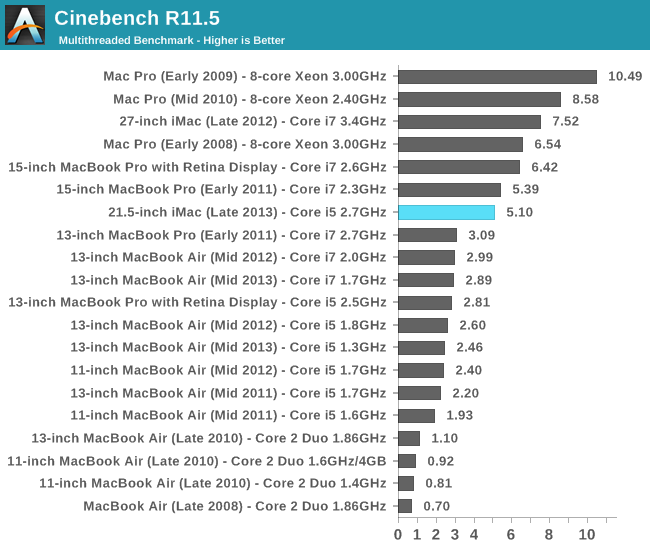
Multithreaded performance is obviously much better than what you’d get from a MacBook Air. You’ll notice the entry-level iMac’s performance here is actually quite similar to that of my old 2011 15-inch MacBook Pro. Although the Core i5-4570R has higher IPC and more TDP to work with, since it’s a desktop Core i5 it doesn’t support Hyper Threading and thus is only a 4 core/4 thread part. The Core i7 in my old MBP however is a 4 core/8 thread part, letting it make better use of each core’s execution resources in heavily threaded applications. This is really no fault of Apple’s, but rather a frustrating side effect of Intel’s SKU segmentation strategy.
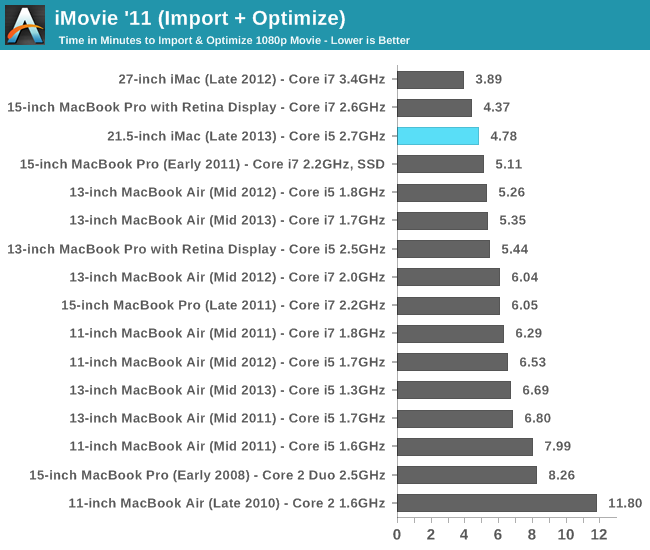
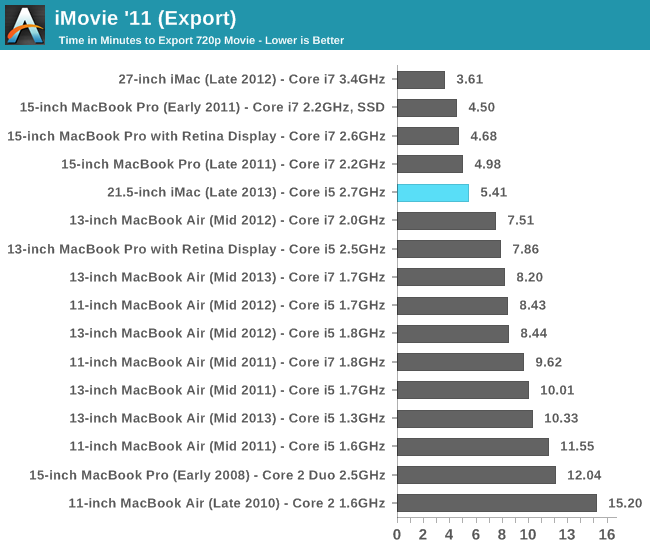
Looking at our iMovie test we see another 50% advantage comparing last year’s highest end 27-inch iMac configuration to the entry-level 21.5-inch model. The explanation boils down to lower max turbo frequencies and fewer number of simultaneous threads supported. There’s also the fact that I’m testing a HDD equipped system and comparing it to those with SSDs, but most of my OS X CPU test suite ends up being largely CPU bound with minimal impact from IO performance.

iPhoto import performance runs pretty much in line with what we’ve seen thus far. The entry-level iMac is a good performer, but power users will definitely want to push for a faster CPU.
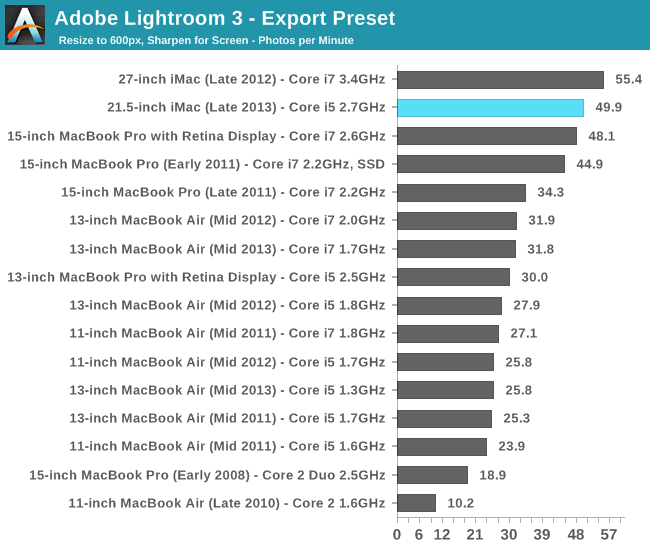
Our Lightroom export test is perhaps the most interesting here. The gap between last year’s 3.4GHz Core i7 and the Crystalwell equipped Core i5-4570R is only 12%. My first thought was to attribute the difference to Crystalwell, but if we look at the gap vs. the 1.7GHz 2013 MacBook Air the iMac’s advantage isn’t really any different than under our iPhoto test. Instead what I believe we’re seeing here is yet another benchmark where Haswell’s architectural advantages shine.
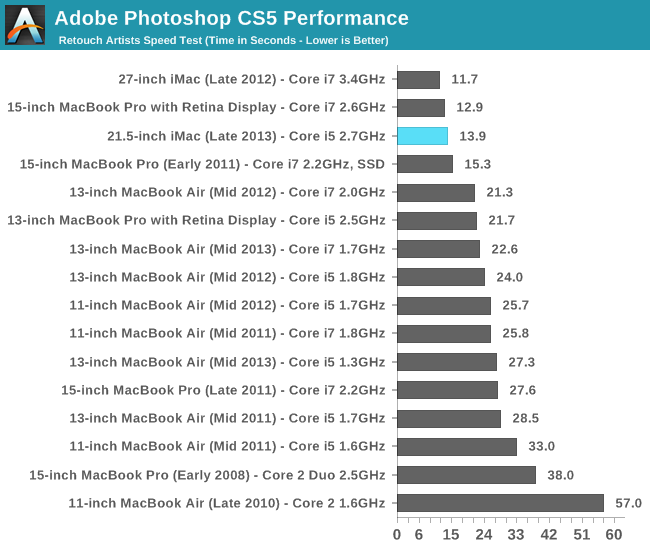
Performance in our Photoshop test is similarly good, with the entry-level iMac coming relatively close (within 20%) to the performance of a high-end 2012 27-inch iMac.
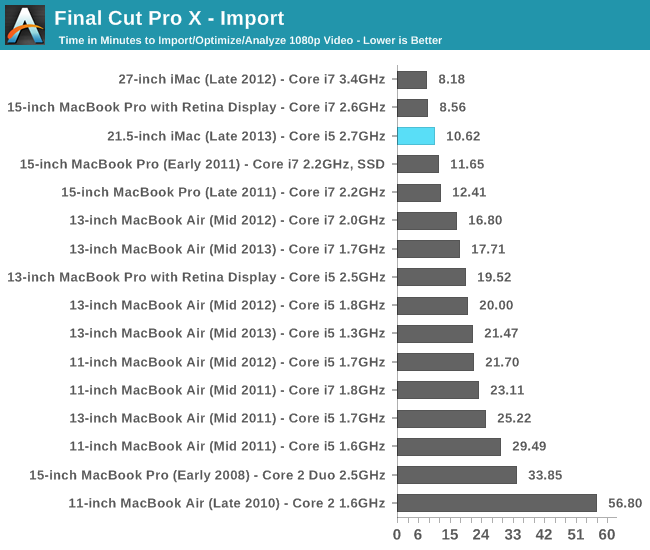
There aren’t any surprises in our FCP-X test either.
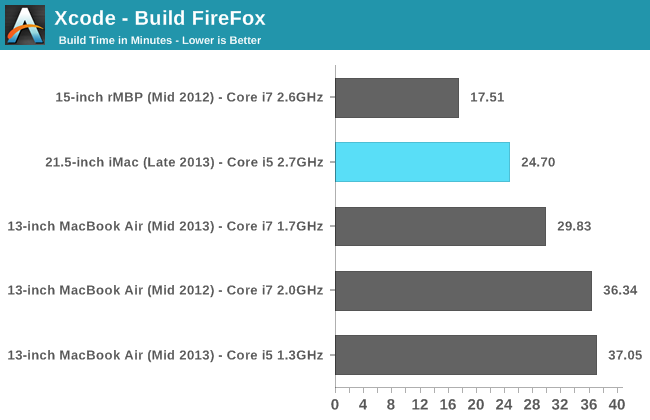
I'm slowly amassing results in our Xcode test. What's interesting about the 21.5-inch iMac's performance here is just how inconsistent it was due to the HDD. Subsequent runs either gave me similar performance to what I'm reporting here, or much, much higher build times. If you needed a reason to opt for an SSD, this is a great one. Even looking at the best performance the iMac can deliver, you can see it's not tremendously quicker than the MacBook Air. With an SSD I'd expect to see far better numbers here.










127 Comments
View All Comments
A5 - Monday, October 7, 2013 - link
Not really, no. They're at about the same level of abstraction since they both sit above the driver stack.Flunk - Monday, October 7, 2013 - link
There is also the issue that the driver sits farther up the stack than it does in Windows. Mach being a hybrid microkernel and all. I'm sure they can close the gap with a lot of work, but it doesn't erase the fact that Mac OS's basic structure is not designed to provide direct hardware access.overzealot - Monday, October 7, 2013 - link
The Windows kernel is also a hybrid microkernel.bestham - Monday, October 7, 2013 - link
"Storage & Fusion Drive – By default all of the iMacs come with a 3.5” mechanical hard drive." The physical harddrive size is differentiated between the 21.5" and the 27". I suspect that you already knew this but it slipped.Anand Lal Shimpi - Monday, October 7, 2013 - link
Thank you, fixed :)rootheday3 - Monday, October 7, 2013 - link
My opinion: Many games look pretty good at medium and it is not clear that the compromise in frame rate is worth it to push for higher settings vs running at medium with higher resolution.Regarding the Iris Pro gaming results - the jump from 13x7 medium (where Iris seems to have plenty of power to spare) up to 16x9 high/very high - this is a change of two variables: both resolution and settings.
Can you rerun some of the gaming tests at 16x9 medium (or maybe native panel resolution - 19x10 medium where 13x7 results were close to 60fps) to see what that shows?
rootheday3 - Monday, October 7, 2013 - link
one other question - is there any ability to OC the IGP in the bios? Typically Intel gpus have a fair bit of OC headroom and it would be interesting to see:1) what kind of performance/playability can be extracted
2) to what extent the igp clock frequency is the limiter on Iris Pro vs cpu, memory bandwidth, etc.
jeffkibuule - Monday, October 7, 2013 - link
This is a Mac! There is no bios, never has been.DanNeely - Monday, October 7, 2013 - link
Everyone who isn't an annoying pedant conflates bios and uefi in general usage.repoman27 - Monday, October 7, 2013 - link
And everyone who isn't an annoying pedant would also realize that jeffkibuule meant, "There is no [user accessible BIOS/EFI/UEFI], never has been."